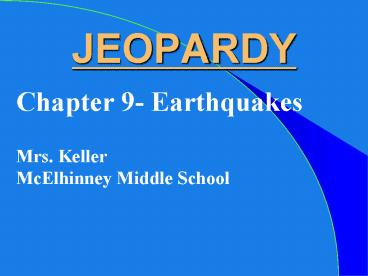JEOPARDY PowerPoint PPT Presentation
1 / 24
Title: JEOPARDY
1
JEOPARDY
- Chapter 9- Earthquakes
- Mrs. Keller
- McElhinney Middle School
2
THE RULES
- Competing teams will be selected.
- Everyone will actively participate.
- No penalties for wrong answers, so try.
- Responses must be in the form of a question such
as What is History? - Each team will be rewarded with points.
- Be positive, encourage your teammates.
- Individual contestants will give their own
answers. - ALEX is the Judge, all decisions are final.
3
Jeopardy
Earthquakes
More Earthquakes
Measuring
Seismic Waves
200
200
200
200
400
400
400
400
600
600
600
600
800
800
800
800
1000
1000
1000
1000
End of Round
4
200
- An earthquake is a form of ______ motion.
- What is stick-slip?
5
400
- Most earthquakes occur at ______ plate
boundaries. - What are transform?
6
600
- The _____ is the location on Earths surface
directly above the area where rock breaks in the
crust in an earthquake. - What is the epicenter?
7
800
- Following an earthquake, small tremors known as
_____ can occur, lasting for hours to days after
the original quake. - What are aftershocks?
8
1000
- This is one way for a fault to occur within a
lithospheric plate instead of at its boundaries. - What is when older plates have been incorporated
inside newer plates?
9
200
- Although a plate may be moving as a single unit,
its boundaries behave as though they were made of
_____. - What are many sections?
10
400
- Section A has an average of 4 earthquakes per
year. Section B has an average of 1 earthquake
every 12 years. Which section would have the
stronger earthquakes? - What is Section B?
11
600
- Deep focus earthquakes generally occur at
- What are subduction zones?
12
800
- Where, when, and how large was the largest
earthquake in the world? - What is Chile, 1960 9.5 magnitude?
13
1000
- The three things needed for stick-slip motion
are - What are 2 bodies in contact, a force, and
friction?
14
200
- _____ are typically the slowest type of seismic
wave, but they cause the most damage in an
earthquake. - What are surface waves?
15
400
- Seismic waves start underground at the
earthquake - What is focus?
16
600
- The fastest type of seismic waves is
- What are P-waves?
17
800
- Seismic waves are also referred to as
- What are body waves?
18
1000
- This information would be most useful in
predicting the occurrence of an earthquake at a
particular location. - What is seismic history?
19
200
200
- A _____ is an instrument that records and
measures seismic waves. - What is a seismograph?
20
400
400
- The _____ scale rates earthquakes according to
the size of the seismic waves recorded on a
seismograph. - What is the Richter scale?
21
600
600
- Each category in the _________ scale is a rating
of the damage suffered by buildings, ground, and
people during an earthquake. - What is the Mercalli Intensity scale?
22
800
800
- San Francisco has experienced several
earthquakes because the _________ Fault passes
right through the city. - What is the San Andreas?
23
1000
- If you knew only the arrival times of P-waves
and S-waves you could figure out ________. - What is the distance to the epicenter?
24
Thank You for Playing Jeopardy

